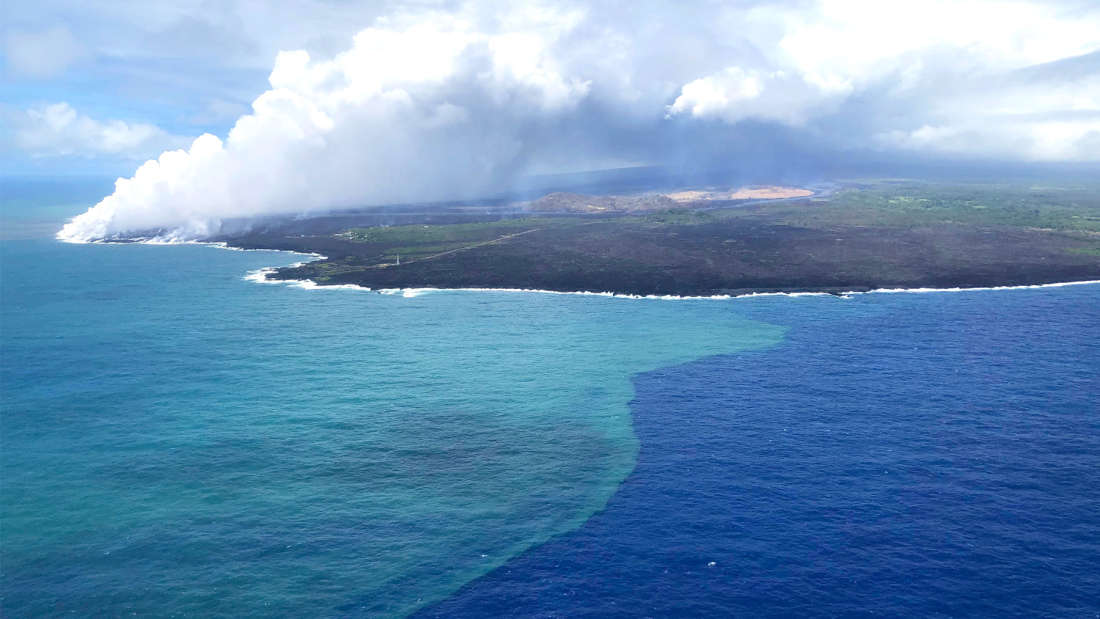O OVGA é um Centro de Ciência que desenvolve atividade de investigação aplicada e de divulgação científica na área da Vulcanologia, da Sismologia e da Geotermia.
Notícia -A A +A
Kilauea’s Volcanic Eruption Set Off An Algae Bloom So Big It Was Picked Up By Satellites - Notícia OVGA 06-09-2019

The presence of extra nutrientes caused a phytoplankton bloom in waters off Kilauea that changed the color of the water.
Image credit: Karin Bjorkman/University of Hawaii
When Hawaii’s Kīlauea volcano erupted last year and poured hundreds of millions of tonnes of lava into nearby waters marine biologists observed it stimulate a plankton bloom so large it could sometimes be seen from space. When they tested the composition of the waters, however, they found part of the mechanism was something no one had predicted.
The waters of the North Pacific Subtropical Gyre are very nutrient-poor and consequently, support very little life. Volcanic lava is rich in essential minerals, making volcanic soils excellent agricultural land, so Samuel Wilson of the University of Hawaii and a large team of colleagues anticipated Kīlauea would lead to a flowering of life. From June to August 2018, while the volcano poured 50-100 cubic meters per second (1,500-3000 cubic feet/second) of lava into the surrounding ocean they observed the biological consequences.
They didn’t need to wait long. Within three days of lava reaching the ocean, the MODIS Aqua satellite detected the characteristic wavelength of chlorophyll, the green pigment emitted by photosynthesizing plants and algae, in nearby waters. Within two weeks a long thin area abounding in phytoplankton stretched 150 kilometers (95 miles) off Hawaii’s coast.

Lava from the Kīlauea volcano caused a large phytoplankton bloom, but the heat from the lava was as important as the minerals it contained. Credit:
Karin Bjorkman/University of Hawaii
Concentrations of chlorophyll were the highest the region had seen for at least 15 years and lasted until a week after the eruption stopped. The quantity of life at the base of the food chain rose 4-6 times compared to normal conditions, providing food for a host of grazing and predatory species. All this despite the fact hot lava was pouring in and solidifying, adding to the coastline, rather than getting dissolved in the water.
Collecting samples, the researchers found the plume was enriched by a mix of higher nitrate levels, silicic acid, iron, and phosphate, the perfect ingredients for plant growth, and so the bloom exploded. However, biologically-available nitrogen is one of the few nutrients lava is low in, and so they were expecting the lack of nitrate to act as a limiting resource for the blooms. Nor did the waters experience much of an increase in nitrogen-fixing organisms that might have provided the nitrate. So where was it coming from, if not from the volcano itself?
In a paper published in the journal Science, Wilson and co. explain that the nitrates had isotopic signatures consistent with waters below 300 meters (1,000 feet) where these nutrients are more abundant.
The heat of lava flowing into deep waters surrounding Hawaii would have created convection currents, they argue. These created a miniature version of the process where upwelling nutrient-rich deep waters create the world’s most productive marine waters, most famously off the Chilean coast.
If, as has been widely proposed, we choose to fight global over-heating by fertilizing vast areas of the ocean that are currently largely lacking in life, the waters off Hawaii may be a good place to start. For that, we will need to identify the combination of nutrients that can make these waters bloom, and Kīlauea has provided us with a demonstration of what is required.
Fonte: IFLScience (05-09-2019)
Adenda OVGA:
Localização do Kilauea (Hawaii)
